Hydrothermal Carbonization Process of Digestate from Sewage Sludge: Chemical and Physical Properties of Hydrochar in Terms of Energy Application
Abstract
:1. Introduction
2. Materials and Methods
2.1. Materials
2.2. Hydrothermal Carbonization Test
2.3. Methods for Analysis of Solid Materials
2.3.1. Combustion Performance and Behaviour
2.3.2. Kinetic Analysis
2.3.3. Structural Analysis
2.4. Methods for Analysis Methods of the Liquid Phase
3. Results and Discussion
4. Conclusions
Author Contributions
Funding
Institutional Review Board Statement
Informed Consent Statement
Data Availability Statement
Acknowledgments
Conflicts of Interest
References
- Lee, M.; Hidaka, T.; Hagiwara, W.; Tsuno, H. Comparative performance and microbial diversity of hyperthermophilic and thermophilic co-digestion of kitchen garbage and excess sludge. Bioresour. Technol. 2009, 100, 578–585. [Google Scholar] [CrossRef] [PubMed]
- Lastella, G.; Testa, C.; Cornacchia, G.; Notornicola, M.; Voltasio, F.; Sharma, V.K. Anaerobic digestion of semi-solid organic waste: Biogas production and its purification. Energy Convers. Manag. 2002, 43, 63–75. [Google Scholar] [CrossRef]
- Themelis, N.J.; Ulloa, P.A. Methane generation in landfills. Renew. Energy 2007, 32, 1243–1257. [Google Scholar] [CrossRef]
- Dahlin, J.; Herbes, C.; Nelles, M. Biogas digestate marketing: Qualitative insights into the supply side. Resour. Conserv. Recycl. 2015, 104, 152–161. [Google Scholar] [CrossRef]
- Werle, S. Sewage sludge-to-energy management in Eastern Europe: A Polish Perspective. Ecol. Chem. Eng. S 2015, 22, 459–469. [Google Scholar] [CrossRef]
- Wilk, M.; Magdziarz, A.; Jayaraman, K.; Szymańska-Chargot, M.; Gökalp, I. Hydrothermal carbonization characteristics of sewage sludge and lignocellulosic biomass. A Comparative Study. Biomass Bioenergy 2019, 120, 166–175. [Google Scholar] [CrossRef]
- Djandja, O.S.; Duan, P.G.; Yin, L.X.; Wang, Z.C.; Duo, J. A Novel machine learning-based approach for prediction of nitrogen content in hydrochar from hydrothermal carbonization of sewage sludge. Energy 2021, 232, 121010. [Google Scholar] [CrossRef]
- Wilk, M.; Śliz, M.; Gajek, M. The Effects of hydrothermal carbonization operating parameters on high-value hydrochar derived from beet pulp. Renew. Energy 2021, 177, 216–228. [Google Scholar] [CrossRef]
- Basso, D.; Patuzzi, F.; Castello, D.; Baratieri, M.; Rada, E.C.; Weiss-Hortala, E.; Fiori, L. Agro-industrial waste to solid biofuel through hydrothermal carbonization. Waste Manag. 2016, 47, 114–121. [Google Scholar] [CrossRef]
- Pham, T.P.T.; Kaushik, R.; Parshetti, G.K.; Mahmood, R.; Balasubramanian, R. Food waste-to-energy conversion technologies: Current status and future directions. Waste Manag. 2015, 38, 399–408. [Google Scholar] [CrossRef]
- Volpe, M.; Fiori, L. From olive waste to solid biofuel through hydrothermal carbonisation: The role of temperature and solid load on secondary char formation and hydrochar energy properties. J. Anal. Appl. Pyrolysis 2017, 124, 63–72. [Google Scholar] [CrossRef]
- Saqib, N.U.; Sharma, H.B.; Baroutian, S.; Dubey, B.; Sarmah, A.K. Valorisation of food waste via hydrothermal carbonisation and techno-economic feasibility assessment. Sci. Total Environ. 2019, 690, 261–276. [Google Scholar] [CrossRef] [PubMed]
- González-Arias, J.; Gómez, X.; González-Castaño, M.; Sánchez, M.E.; Rosas, J.G.; Cara-Jiménez, J. Insights into the product quality and energy requirements for solid biofuel production: A comparison of hydrothermal carbonization, pyrolysis and torrefaction of olive tree pruning. Energy 2022, 238, 122022. [Google Scholar] [CrossRef]
- Wilk, M.; Magdziarz, A.; Kalemba-Rec, I.; Szymańska-Chargot, M. Upgrading of green waste into carbon-rich solid biofuel by hydrothermal carbonization: The effect of process parameters on hydrochar derived from acacia. Energy 2020, 202, 117717. [Google Scholar] [CrossRef]
- Yuan, C.; Wang, S.; Qian, L.; Barati, B.; Gong, X.; Abomohra, A.E.; Wang, X.; Esakkimuthu, S.; Hu, Y.; Liu, L. Effect of cosolvent and addition of catalyst (HZSM-5) on hydrothermal liquefaction of macroalgae. Int. J. Energy Res. 2019, 43, 4843. [Google Scholar] [CrossRef]
- Krylova, A.Y.; Zaitchenko, V.M. Hydrothermal carbonization of biomass: A review. Solid Fuel Chem. 2018, 52, 91–103. [Google Scholar] [CrossRef]
- Zhou, S.; Liang, H.; Han, L.; Huang, G.; Yang, Z. The influence of manure feedstock, slow pyrolysis, and hydrothermal temperature on manure thermochemical and combustion properties. Waste Manag. 2019, 88, 85–95. [Google Scholar] [CrossRef]
- Lee, J.; Lee, K.; Sohn, D.; Kim, Y.M.; Park, K.Y. Hydrothermal carbonization of lipid extracted algae for hydrochar production and feasibility of using hydrochar as a solid fuel. Energy 2018, 153, 913–920. [Google Scholar] [CrossRef]
- Pawlak-Kruczek, H.; Niedzwiecki, L.; Sieradzka, M.; Mlonka-Mędrala, A.; Baranowski, M.; Serafin-Tkaczuk, M.; Magdziarz, A. Hydrothermal carbonization of agricultural and municipal solid waste digestates—Structure and energetic properties of the solid products. Fuel 2020, 275, 117837. [Google Scholar] [CrossRef]
- Fang, J.; Zhan, L.; Ok, Y.S.; Gao, B. Minireview of potential applications of hydrochar derived from hydrothermal carbonization of biomass. J. Ind. Eng. Chem. 2018, 57, 15–21. [Google Scholar] [CrossRef]
- Azzaz, A.A.; Khiari, B.; Jellali, S.; Ghimbeu, C.M.; Jeguirim, M. Hydrochars production, characterization and application for wastewater treatment: A review. Renew. Sustain. Energy Rev. 2020, 127, 109882. [Google Scholar] [CrossRef]
- Wang, T.; Zhai, Y.; Zhu, Y.; Li, C.; Zeng, G. A review of the hydrothermal carbonization of biomass waste for hydrochar formation: Process conditions, fundamentals, and physicochemical properties. Renew. Sustain. Energy Rev. 2018, 90, 223–247. [Google Scholar] [CrossRef]
- Tasca, A.L.; Puccini, M.; Gori, R.; Corsi, I.; Galletti, A.M.R.; Vitolo, S. Hydrothermal carbonization of sewage sludge: A critical analysis of process severity, hydrochar properties and environmental implications. Waste Manag. 2019, 93, 1–13. [Google Scholar] [CrossRef] [PubMed]
- Zhai, Y.; Liu, X.; Zhu, Y.; Peng, C.; Wang, T.; Zhu, L.; Li, C.; Zeng, G. Hydrothermal carbonization of sewage sludge: The effect of feed-water pH on fate and risk of heavy metals in hydrochars. Bioresour. Technol. 2016, 218, 183–188. [Google Scholar] [CrossRef]
- Werle, S.; Dudziak, M. Evaluation of toxicity of sewage sludge and gasification waste-products. Przem. Chem. 2013, 92, 1350–1353. [Google Scholar]
- Shi, W.; Liu, C.; Ding, D.; Lei, Z.; Yang, Y.; Feng, C.; Zhang, Z. Immobilization of heavy metals in sewage sludge by using subcritical water technology. Bioresour. Technol. 2013, 137, 18–24. [Google Scholar] [CrossRef]
- Berslin, D.; Reshmi, A.; Sivaprakash, B.; Rajamohan, N.; Kumar, P.S. Remediation of emerging metal pollutants using environment friendly biochar- Review on applications and mechanism. Chemosphere 2022, 290, 133384. [Google Scholar] [CrossRef]
- Masoumi, S.; Borugadda, V.B.; Nanda, S.; Dalai, A.K. Hydrochar: A Review on Its Production Technologies and Applications. Catalysts 2021, 11, 939. [Google Scholar] [CrossRef]
- Nandhini, R.; Berslin, D.; Sivaprakash, B.; Rajamohan, N.; Vo, D.V.N. Thermochemical conversion of municipal solid waste into energy and hydrogen: A review. Environ. Chem. Lett. 2022, 20, 1645–1669. [Google Scholar] [CrossRef]
- Monisha, R.S.; Mani, R.L.; Sivaprakash, B.; Rajamohan, N.; Vo, D.V.N. Green remediation of pharmaceutical wastes using biochar: A review. Environ. Chem. Lett. 2022, 20, 681–704. [Google Scholar] [CrossRef]
- Shi, W.; Liu, C.; Shu, Y.; Feng, C.; Lei, Z.; Zhang, Z. Synergistic Effect of rice husk addition on hydrothermal treatment of sewage sludge: Fate and environmental risk of heavy metals. Bioresour. Technol. 2013, 149, 496–502. [Google Scholar] [CrossRef] [PubMed] [Green Version]
- Sharma, H.B.; Sarmah, A.K.; Dubey, B. Hydrothermal carbonization of renewable waste biomass for solid biofuel production: A discussion on process mechanism, the influence of process parameters, environmental performance and fuel properties of hydrochar. Renew. Sustain. Energy Rev. 2020, 123, 109761. [Google Scholar] [CrossRef]
- Titirici, M.M.; Funke, A.; Kruse, A. Hydrothermal Carbonization of Biomass. In Recent Advances in Thermo-Chemical Conversion of Biomass; Elsevier: Amsterdam, The Netherlands, 2015; pp. 325–352. [Google Scholar]
- Wilk, M.; Śliz, M.; Lubieniecki, B. Hydrothermal co-carbonization of sewage sludge and fuel additives: Combustion performance of hydrochar. Renew. Energy 2021, 178, 1046–1056. [Google Scholar] [CrossRef]
- Gao, N.; Li, Z.; Quan, C.; Miskolczi, N.; Egedy, A. A new method combining hydrothermal carbonization and mechanical compression in-situ for sewage sludge dewatering: Bench-scale verification. J. Anal. Appl. Pyrolysis 2019, 139, 187–195. [Google Scholar] [CrossRef]
- Breulmann, M.; van Afferden, M.; Müller, R.A.; Schulz, E.; Fühner, C. Process conditions of pyrolysis and hydrothermal carbonization affect the potential of sewage sludge for soil carbon sequestration and amelioration. J. Anal. Appl. Pyrolysis 2017, 124, 256–265. [Google Scholar] [CrossRef]
- De la Rubia, M.A.; Villamil, J.A.; Rodriguez, J.J.; Mohedano, A.F. Effect of inoculum source and initial concentration on the anaerobic digestion of the liquid fraction from hydrothermal carbonisation of sewage sludge. Renew. Energy 2018, 127, 697–704. [Google Scholar] [CrossRef]
- Wang, S.; Persson, H.; Yang, W.; Jönsson, P.G. Pyrolysis Study of hydrothermal carbonization-treated digested sewage sludge using a py-gc/ms and a bench-scale pyrolyzer. Fuel 2020, 262, 116335. [Google Scholar] [CrossRef]
- Aragón-Briceño, C.; Ross, A.B.; Camargo-Valero, M.A. Evaluation and comparison of product yields and bio-methane potential in sewage digestate following hydrothermal treatment. Appl. Energy 2017, 208, 1357–1369. [Google Scholar] [CrossRef]
- Parmar, K.R.; Ross, A.B. Integration of hydrothermal carbonisation with anaerobic digestion; opportunities for valorisation of digestate. Energies 2019, 12, 1586. [Google Scholar] [CrossRef]
- Cao, Z.; Jung, D.; Olszewski, M.P.; Arauzo, P.J.; Kruse, A. Hydrothermal carbonization of biogas digestate: Effect of digestate origi5 and process conditions. Waste Manag. 2019, 100, 138–150. [Google Scholar] [CrossRef]
- Werle, S. A reburning process using sewage sludge-derived syngas. Chem. Pap. 2012, 66, 99–107. [Google Scholar] [CrossRef]
- Cao, Z.; Hülsemann, B.; Wüst, D.; Illi, L.; Oechsner, H.; Kruse, A. Valorization of maize silage digestate from two-stage anaerobic digestion by hydrothermal carbonization. Energy Convers. Manag. 2020, 222, 113218. [Google Scholar] [CrossRef]
- Wilk, M. A Novel Method of Sewage Sludge Pre-Treatment-HTC. In Proceedings of the 1st International Conference on the Sustainable Energy and Environment Development (SEED 2016), Kraków, Poland, 17–19 May 2016; Volume 10. [Google Scholar]
- Śliz, M.; Tuci, F.; Czerwińska, K.; Fabrizi, S.; Lombardi, L.; Wilk, M. Hydrothermal carbonization of the wet fraction from mixed municipal solid waste: Hydrochar characteristics and energy balance. Waste Manag. 2022, 151, 39–48. [Google Scholar] [CrossRef] [PubMed]
- Ozawa, T. Estimation of activation energy by isoconversion methods. Thermochim. Acta 1992, 203, 159–165. [Google Scholar] [CrossRef]
- He, C.; Giannis, A.; Wang, J.Y. Conversion of sewage sludge to clean solid fuel using hydrothermal carbonization: Hydrochar fuel characteristics and combustion behavior. Appl. Energy 2013, 111, 257–266. [Google Scholar] [CrossRef]
- Song, C.-Z.; Wen, J.-H.; Li, Y.-Y.; Dan, H.; Shi, X.-Y.; Xin, S. Thermogravimetric assessment of combustion characteristics of blends of lignite coals with coal gangue. In Proceedings of the 3rd Annual International Conference on Mechanics and Mechanical Engineering (MME 2016), Chengdu, China, 16–18 December 2016; Volume 105, pp. 490–495. [Google Scholar]
- Magdziarz, A.; Wilk, M.; Straka, R. Combustion Process of torrefied wood biomass: A kinetic study. J. Therm. Anal. Calorim. 2017, 127, 1339–1349. [Google Scholar] [CrossRef]
- Barzegar, R.; Yozgatligil, A.; Olgun, H.; Atimtay, A.T. TGA and kinetic study of different torrefaction conditions of wood biomass under air and oxy-fuel combustion atmospheres. J. Energy Inst. 2020, 93, 889–898. [Google Scholar] [CrossRef]
- Ren, S.; Lei, H.; Wang, L.; Bu, Q.; Chen, S.; Wu, J. Thermal Behaviour and kinetic study for woody biomass torrefaction and torrefied biomass pyrolysis by TGA. Biosyst. Eng. 2013, 116, 420–426. [Google Scholar] [CrossRef]
- Peng, C.; Zhai, Y.; Zhu, Y.; Xu, B.; Wang, T.; Li, C.; Zeng, G. Production of char from sewage sludge employing hydrothermal carbonization: Char properties, combustion behavior and thermal characteristics. Fuel 2016, 176, 110–118. [Google Scholar] [CrossRef]
- Zheng, X.; Jiang, Z.; Ying, Z.; Song, J.; Chen, W.; Wang, B. Role of feedstock properties and hydrothermal carbonization conditions on fuel properties of sewage sludge-derived hydrochar using multiple linear regression technique. Fuel 2020, 271, 117609. [Google Scholar]
- Lin, Y.; Wang, D.; Wang, T. Ethanol Production from pulp & paper sludge and monosodium glutamate waste liquor by simultaneous saccharification and fermentation in batch condition. Chem. Eng. J. 2012, 191, 31–37. [Google Scholar]
- Zhuang, X.; Zhan, H.; Song, Y.; He, C.; Huang, Y.; Yin, X.; Wu, C. Insights into the evolution of chemical structures in lignocellulose and non-lignocellulose biowastes during hydrothermal carbonization (HTC). Fuel 2019, 236, 960–974. [Google Scholar] [CrossRef]
- Wang, L.; Chang, Y.; Li, A. Hydrothermal carbonization for energy-efficient processing of sewage sludge: A review. Renew. Sustain. Energy Rev. 2019, 108, 423–440. [Google Scholar] [CrossRef]
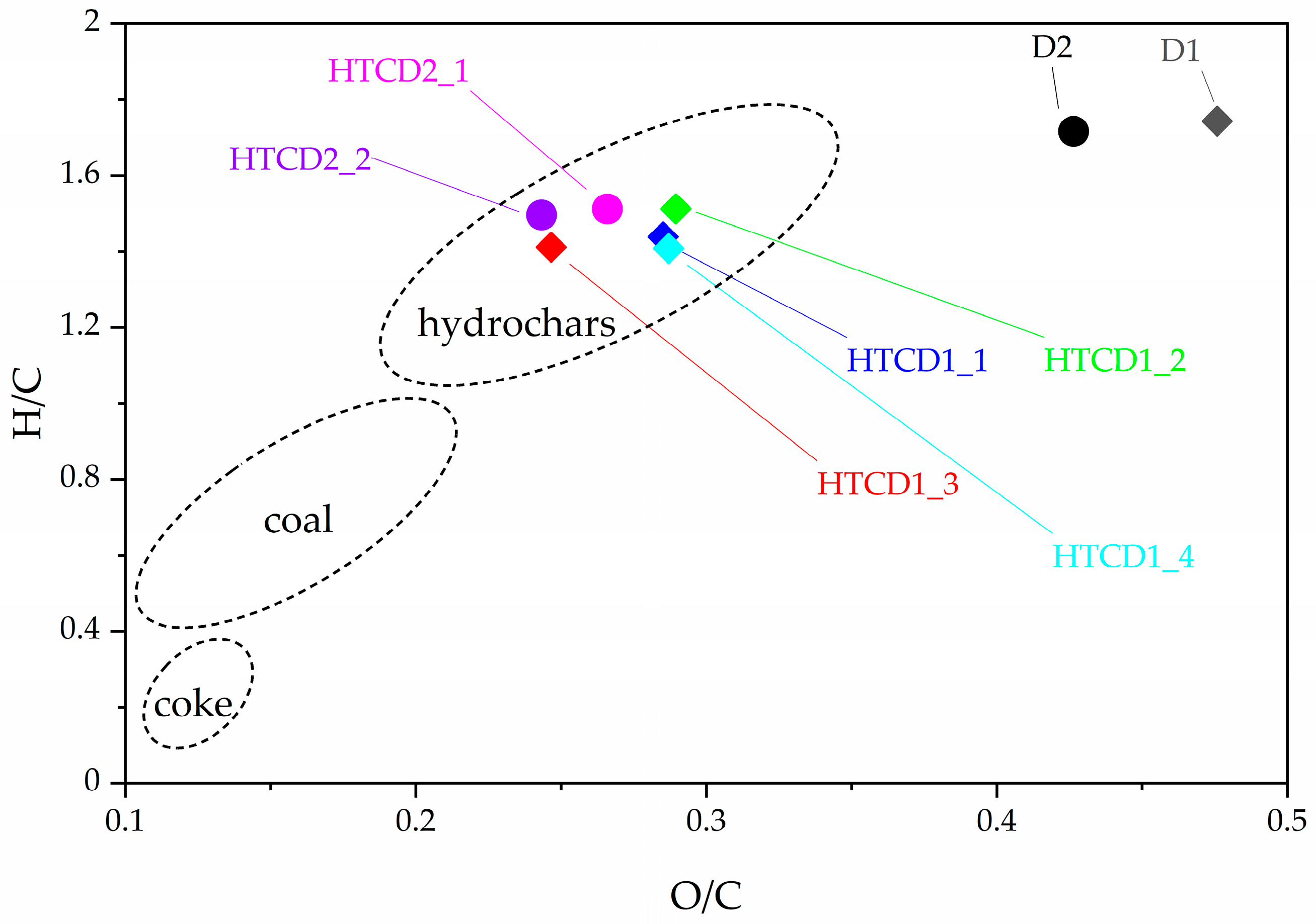
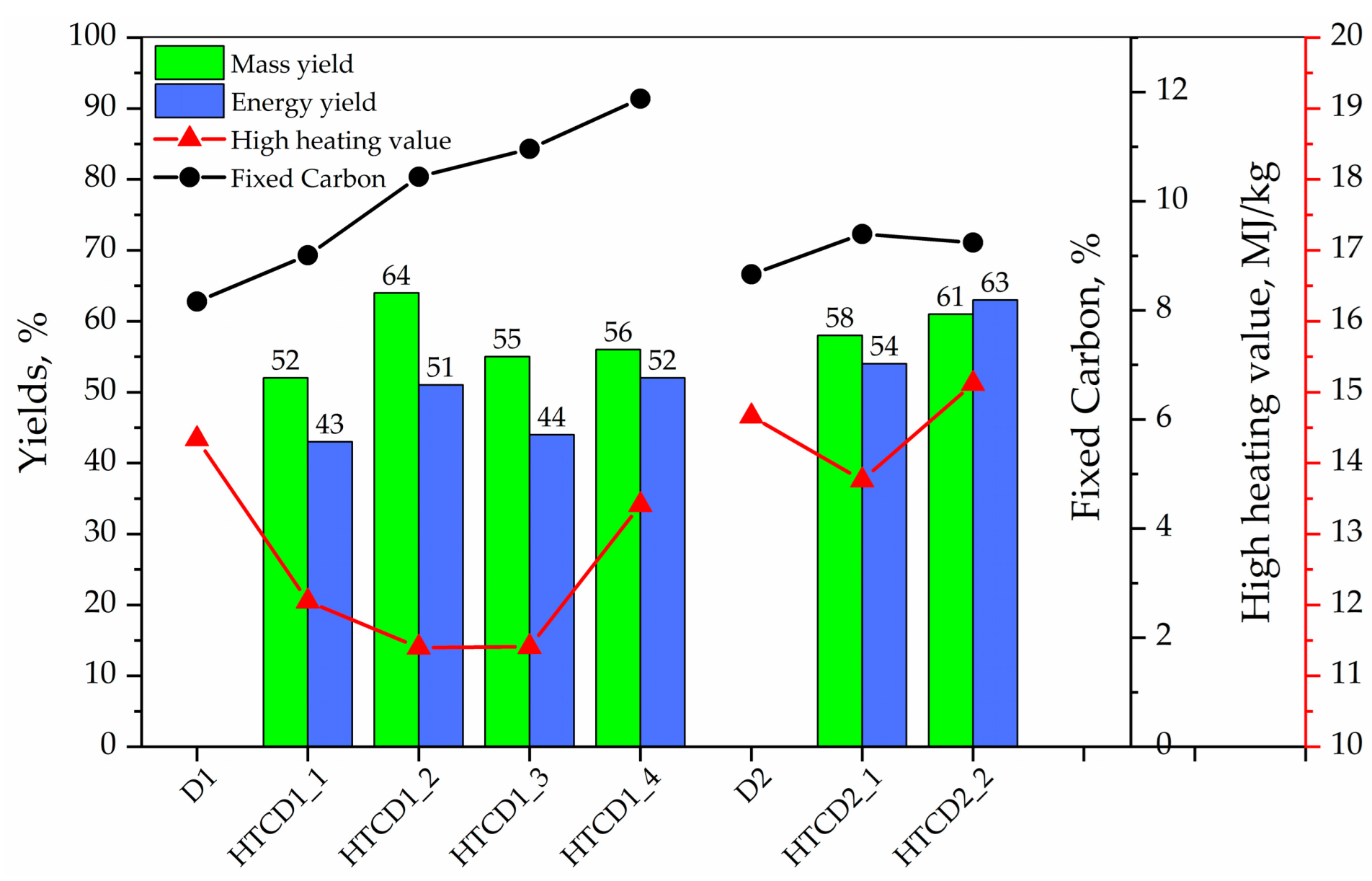
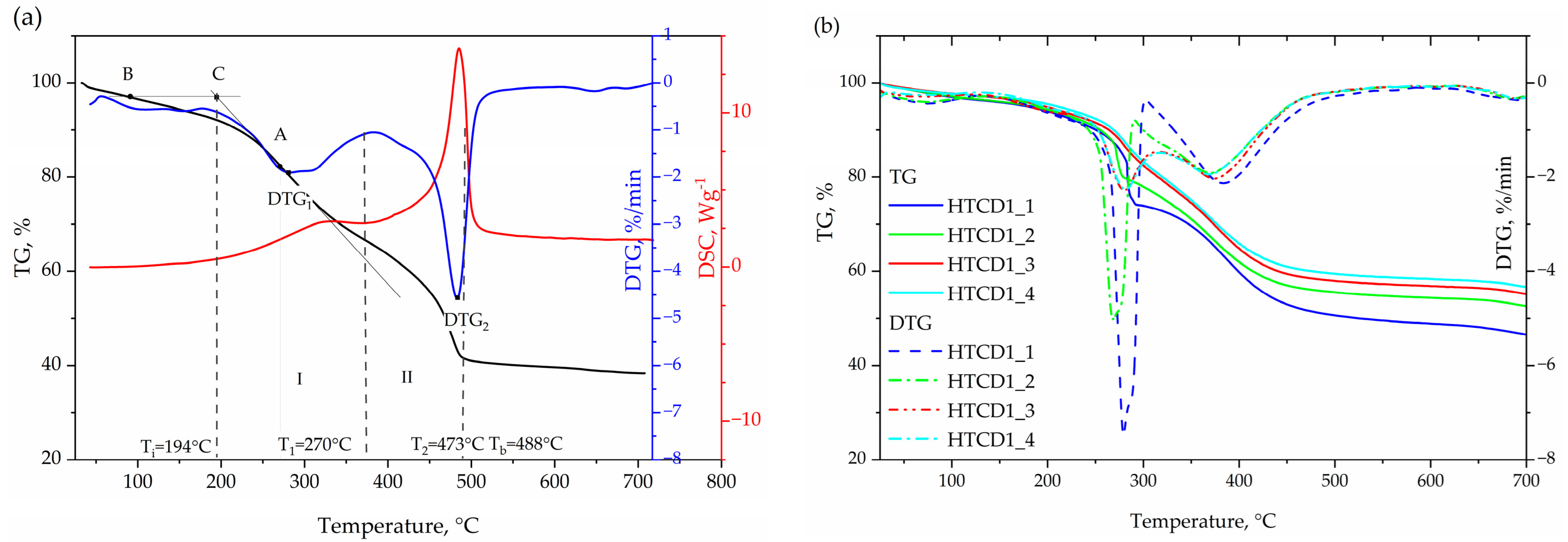
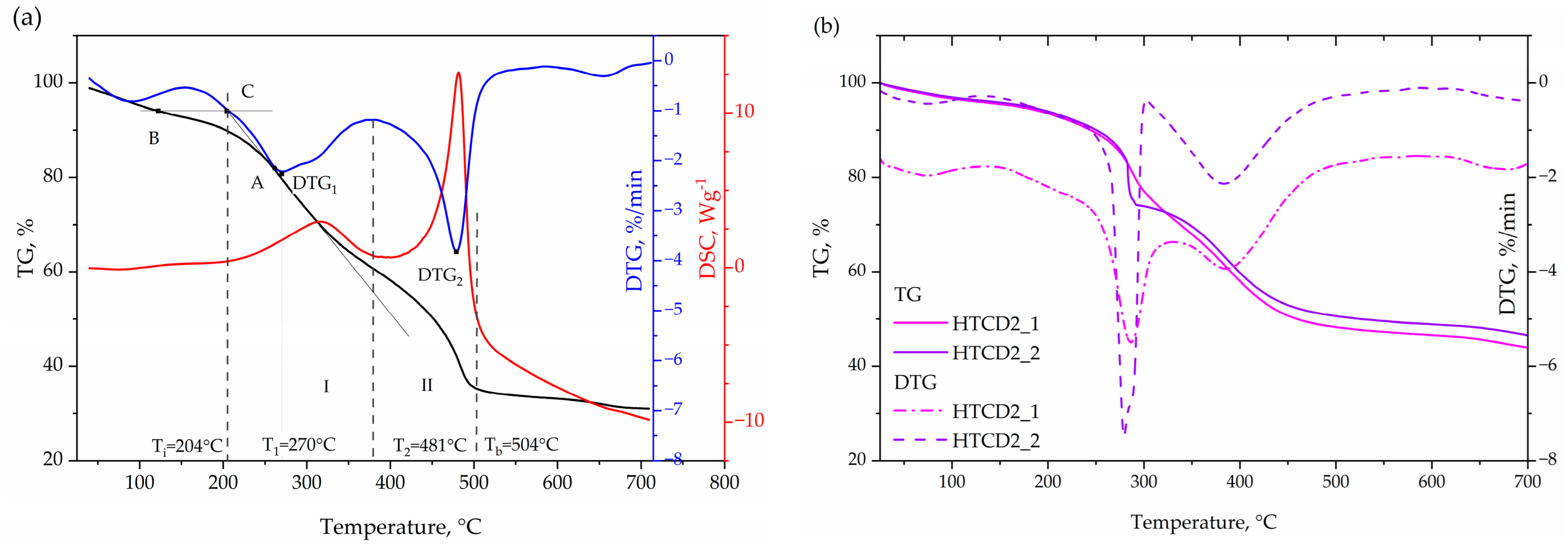
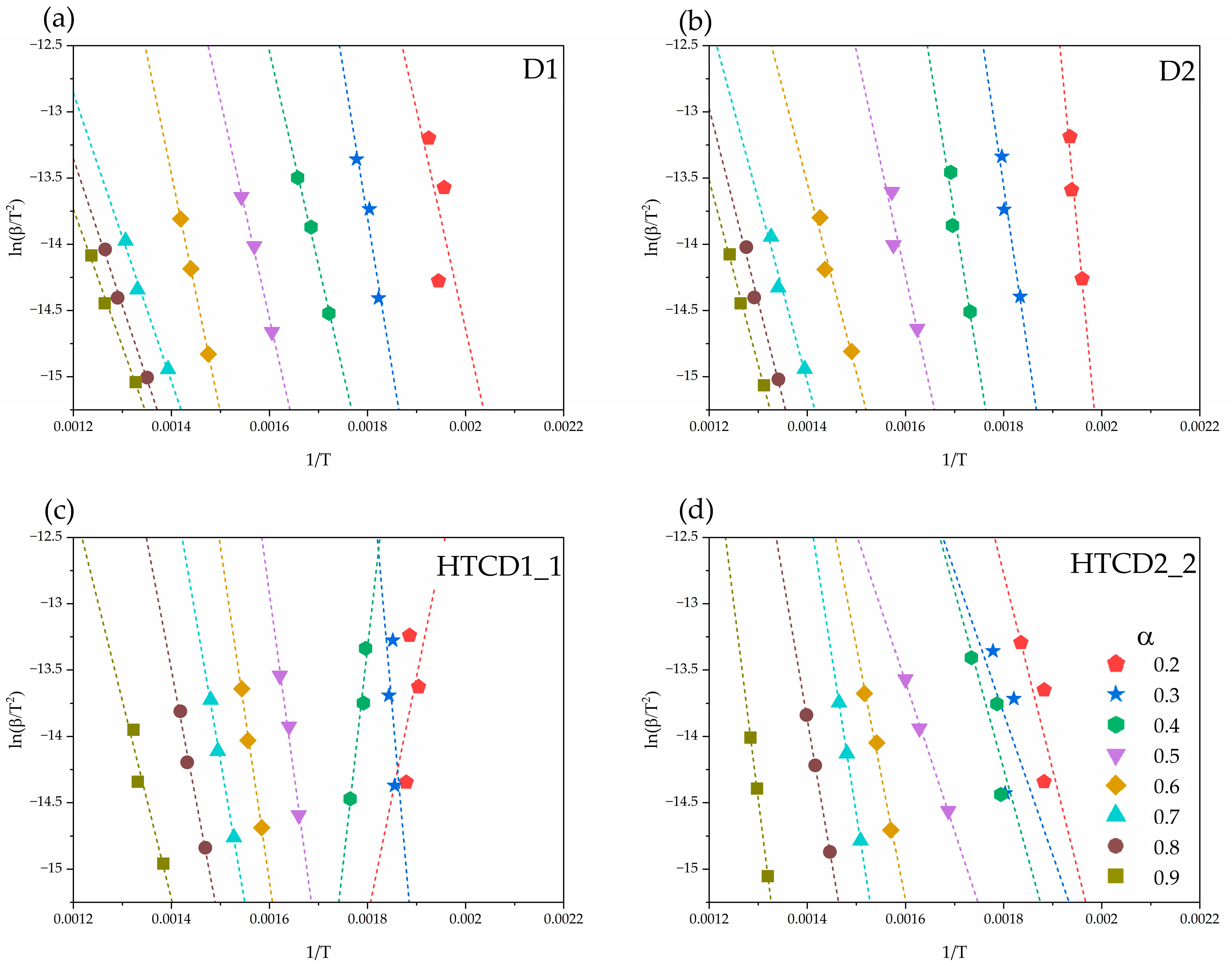
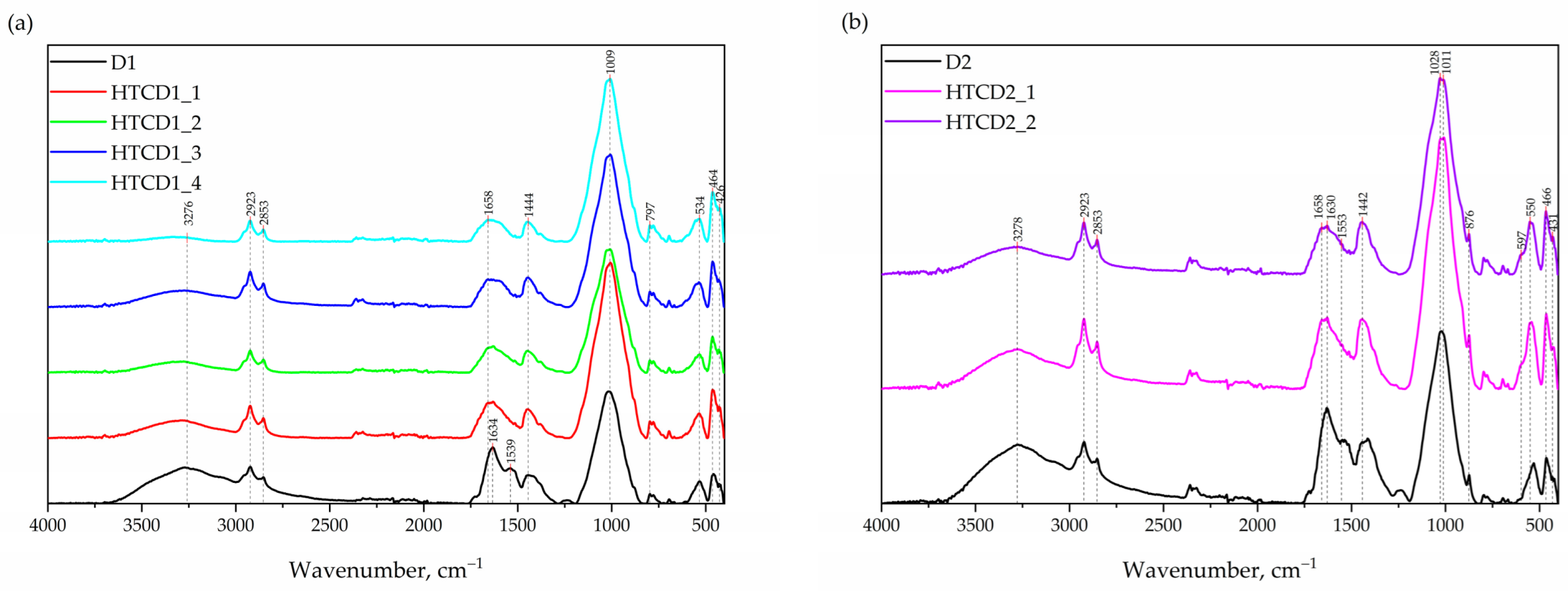
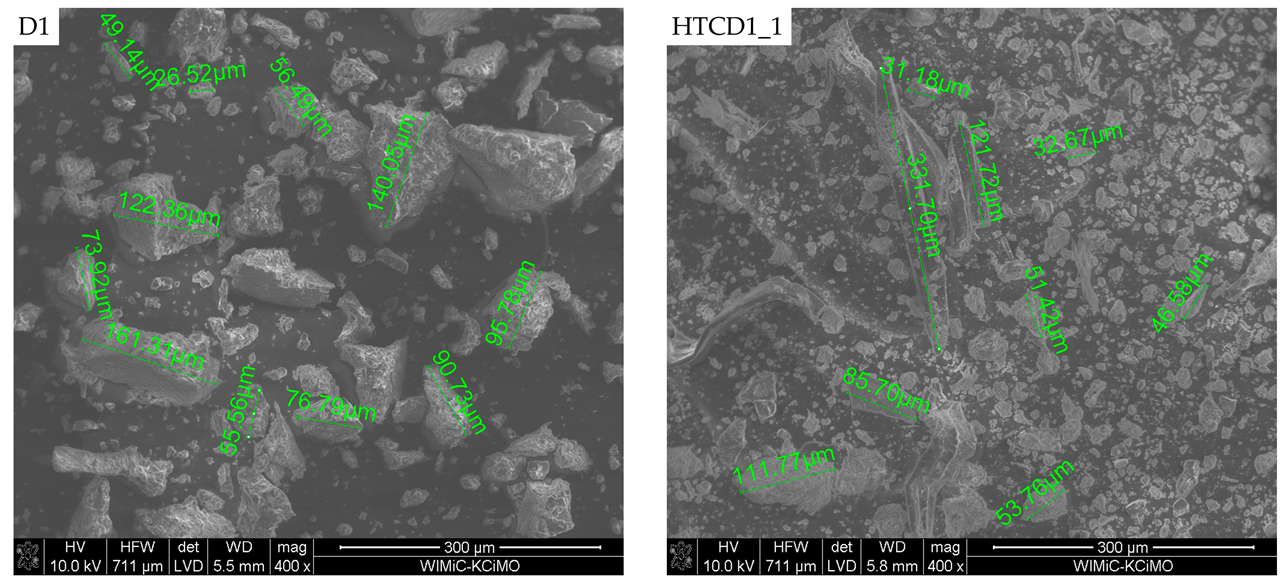
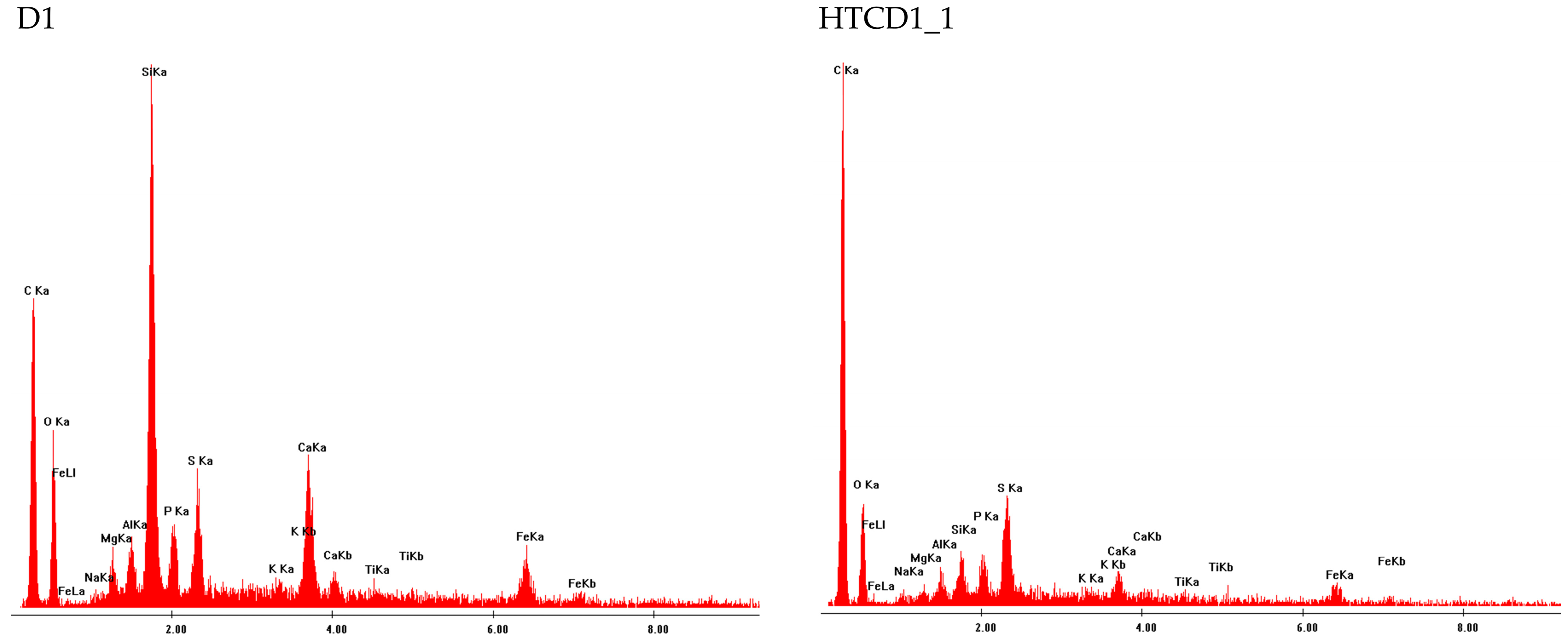

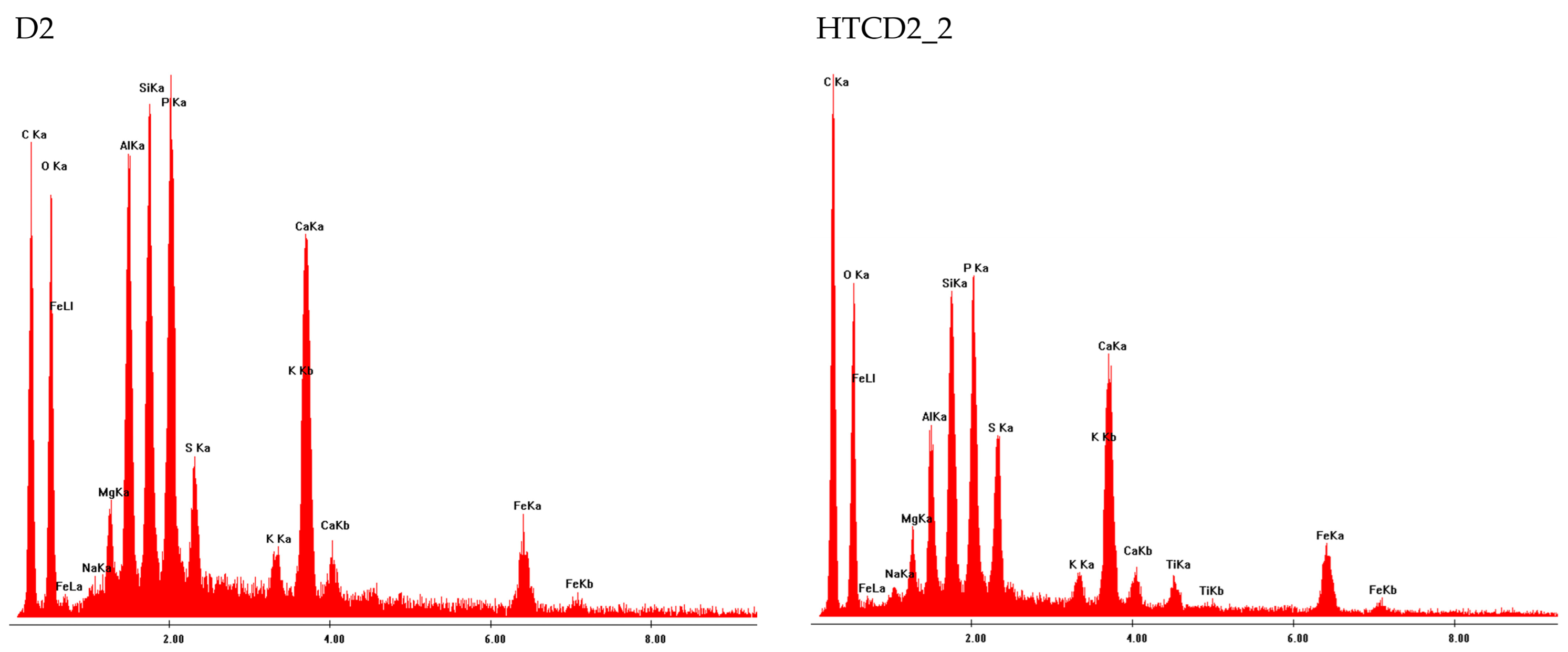
| D1 | HTCD1_1 | HTCD1_2 | HTCD1_3 | HTCD1_4 | D2 | HTCD2_1 | HTCD2_2 | |
|---|---|---|---|---|---|---|---|---|
| Temperature, °C | 200 | 200 | 220 | 220 | 200 | 200 | ||
| Digestate to water ratio | 1:8 | 1:11 | 1:8 | 1:11 | 1:8 | 1:8 | ||
| Residence time | 4 | 4 | 4 | 4 | 2 | 4 | ||
| Ultimate analysis | ||||||||
| C, % | 29.6 | 26.2 | 26.50 | 26.70 | 26.00 | 32.8 | 30.4 | 30.8 |
| H, % | 4.3 | 3.14 | 3.34 | 3.14 | 3.05 | 4.69 | 3.83 | 3.84 |
| N, % | 4.35 | 2.32 | 2.14 | 2.16 | 1.95 | 4.74 | 2.55 | 2.52 |
| S, % | 1.58 | 1.42 | 1.32 | 1.36 | 1.51 | 1.61 | 1.43 | 1.55 |
| O, % | 20.11 | 11.12 | 12.34 | 9.44 | 11.21 | 22.85 | 12.67 | 11.93 |
| Proximate analysis | ||||||||
| FC, % | 8.16 | 9.01 | 10.45 | 10.96 | 11.88 | 8.66 | 9.42 | 9.24 |
| VM, % | 50.45 | 34.03 | 33.08 | 31.18 | 30.58 | 53.83 | 39.59 | 39.46 |
| Ash, % | 40.06 | 55.80 | 54.36 | 57.20 | 56.28 | 33.31 | 49.12 | 49.36 |
| M, % | 1.33 | 1.16 | 2.11 | 0.66 | 1.26 | 4.20 | 1.89 | 1.94 |
| Fuel ratio | ||||||||
| FC/VM | 0.16 | 0.26 | 0.32 | 0.35 | 0.39 | 0.16 | 0.24 | 0.23 |
| Heating values | ||||||||
| HHV, MJ/kg | 14.34 | 11.40 | 11.40 | 13.41 | 11.41 | 14.66 | 13.76 | 15.12 |
| LHV, MJ/kg | 13.57 | 10.82 | 11.45 | 12.73 | 10.80 | 13.75 | 13.09 | 14.46 |
| Material | D1 | HTCD1_1 | HTCD1_2 | HTCD1_3 | HTCD1_4 | D2 | HTCD2_1 | HTCD2_2 |
|---|---|---|---|---|---|---|---|---|
| Temperature, °C | 200 | 200 | 220 | 220 | 200 | 200 | ||
| Digestate to water ratio | 1:8 | 1:11 | 1:8 | 1:11 | 1:8 | 1:8 | ||
| Residence time | 4 | 4 | 4 | 4 | 2 | 4 | ||
| Ti, °C | 194 | 250 | 255 | 225 | 225 | 204 | 250 | 257 |
| Tb, °C | 488 | 438 | 423 | 427 | 423 | 504 | 442 | 438 |
| T1, °C | 270 | 280 | 272 | 280 | 282 | 270 | 290 | 280 |
| DTG1, %/min | −4.00 | −7.67 | −5 | −2.27 | −2.25 | −2.72 | −4.58 | −7.46 |
| T2, °C | 473 | 384 | 363 | 374 | 370 | 481 | 384 | 382 |
| DTG2, %/min | −5.50 | −2.54 | −2.36 | −2.02 | −1.94 | −5.29 | −2.54 | −2.16 |
| Di, %/min3·10−2 | 0.63 | 1.41 | 0.94 | 0.48 | 0.47 | 0.66 | 0.82 | 1.34 |
| Db, %/min4·10−5 | 9.5 | 30.9 | 22.4 | 9.3 | 10.3 | 12.3 | 18.0 | 30.9 |
| S, %2/(min2·°C3)·10−8 | 11.7 | 21.1 | 12.1 | 6.6 | 6.4 | 12.4 | 12.9 | 19.4 |
| Hf, %/(min·°C2) | 875 | 972 | 973 | 1026 | 1014 | 813 | 992 | 967 |
| Material | Ea, kJ/kmol | ||
|---|---|---|---|
| Friedman | Kissinger-Akahira-Sunose | Flynn-Wall-Ozawa | |
| D1 | 132 | 179 | 152 |
| HTCD1 | 169 | 180 | 182 |
| D2 | 165 | 166 | 153 |
| HTCD2 | 168 | 169 | 152 |
| Material | HTCD1_1 | HTCD1_2 | HTCD1_3 | HTCD1_4 | HTCD2_1 | HTCD2_2 |
|---|---|---|---|---|---|---|
| pH | 7.33 | 7.00 | 7.74 | 7.46 | 7.09 | 7.13 |
| pHd | 9.5 | 9.18 | 8.87 | 8.95 | 9.09 | 8.94 |
| Conductivity, mS | 13.95 | 10.36 | 16.84 | 12.89 | 11.27 | 12.68 |
| Conductivityd, mS | 3.09 | 2.28 | 8.88 | 7.09 | 3.85 | 5.20 |
| COD, gO2 L−1 | 30.3 | 22.62 | 29.67 | 23.85 | 28.72 | 26.76 |
| CODd, gO2 L−1 | 3.16 | 1.49 | 4.57 | 3.33 | 2.77 | 2.37 |
| BOD, gO2 L−1 | 1.76 | 1.04 | 1.32 | 1.52 | 1.08 | 1.12 |
| BODd, gO2 L−1 | 0.8 | 0.72 | 0.72 | 0.84 | 0.60 | 0.48 |
Publisher’s Note: MDPI stays neutral with regard to jurisdictional claims in published maps and institutional affiliations. |
© 2022 by the authors. Licensee MDPI, Basel, Switzerland. This article is an open access article distributed under the terms and conditions of the Creative Commons Attribution (CC BY) license (https://creativecommons.org/licenses/by/4.0/).
Share and Cite
Wilk, M.; Gajek, M.; Śliz, M.; Czerwińska, K.; Lombardi, L. Hydrothermal Carbonization Process of Digestate from Sewage Sludge: Chemical and Physical Properties of Hydrochar in Terms of Energy Application. Energies 2022, 15, 6499. https://doi.org/10.3390/en15186499
Wilk M, Gajek M, Śliz M, Czerwińska K, Lombardi L. Hydrothermal Carbonization Process of Digestate from Sewage Sludge: Chemical and Physical Properties of Hydrochar in Terms of Energy Application. Energies. 2022; 15(18):6499. https://doi.org/10.3390/en15186499
Chicago/Turabian StyleWilk, Małgorzata, Marcin Gajek, Maciej Śliz, Klaudia Czerwińska, and Lidia Lombardi. 2022. "Hydrothermal Carbonization Process of Digestate from Sewage Sludge: Chemical and Physical Properties of Hydrochar in Terms of Energy Application" Energies 15, no. 18: 6499. https://doi.org/10.3390/en15186499
APA StyleWilk, M., Gajek, M., Śliz, M., Czerwińska, K., & Lombardi, L. (2022). Hydrothermal Carbonization Process of Digestate from Sewage Sludge: Chemical and Physical Properties of Hydrochar in Terms of Energy Application. Energies, 15(18), 6499. https://doi.org/10.3390/en15186499









